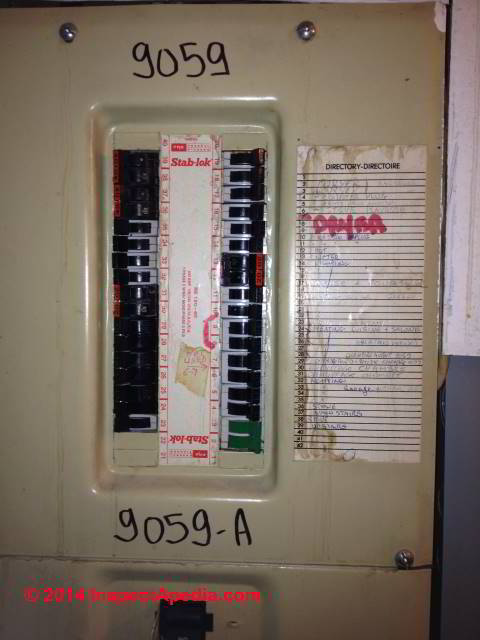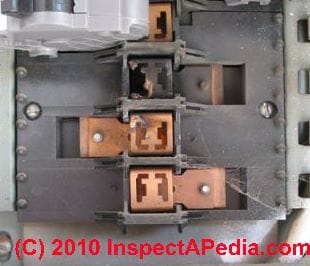 Federal Pioneer Stab-Lok® -
Federal Pioneer Stab-Lok® -
FP Electrical Panel Safety FAQs
Q&A on Safety & Performance of Canadian FP Circuit Breakers
- POST a QUESTION or COMMENT about the safety and reliability of older vs more contemporary Federal Pioneer FP Electrical Panels and Circuit Breakers
Federal Pioneer Stab-Lok breaker & Panel Safety Questions & Answers.
This article series explains the possible hazards of the Federal Pioneer Stab-Lok® electrical panels & circuit breakers,in more recently manufactured FP product versions.
Independent test data on Federal Pioneer circuit breakers sold in Canada indicate that recently-produced FP breakers (1992 and 2015) perform similarly to U.S. FPE circuit breakers, having similar failure rates.
InspectAPedia tolerates no conflicts of interest. We have no relationship with advertisers, products, or services discussed at this website.
- Daniel Friedman, Publisher/Editor/Author - See WHO ARE WE?
Federal Pioneer Stab-Lok® Electrical Panel / Breaker Safety Q&A
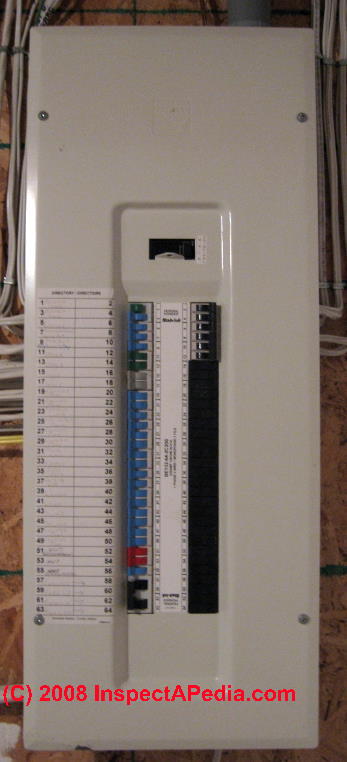 These questions and answers about the performance and safety of Canadian FP or Federal Pioneer circuit breakers and elecrical panels were posted originally
These questions and answers about the performance and safety of Canadian FP or Federal Pioneer circuit breakers and elecrical panels were posted originally
at FEDERAL PIONEER PANEL SAFETY - be sure to review the study and failure data given there.
The Federal Pioneer brand of electrical panels and circuit breakers is a Canadian version of the Federal Pacific Electric Stab-Lok® equipment.
On 2021-05-05 - by (mod) - F-bus and E-Bus differences in FP / FPE Panels
@Anonymous,
Both Federal Pacific and Federal Pioneer use two bus designs, an F-shaped and an E-shaped connector opening on the bus
Each, then expects F-shaped or E-shaped breaker connectors and either "brand" would accept the breaker that matches its bus connector opening.
FP and FPE are essentially identical in design, performance (high failure rates), and in thir poor safety record.
Therefore no one should be replacing FP or FPE breakers, they should be replacing the panel itself. It is , as you will read above on this page, unsafe.
On 2021-05-04 by Anonymous - use a Federal Pacific Stab Lok breaker in a Federal Pioneer Panel?
Can you use a federal pacific breaker in a federal pioneer panel?
On 2020-11-10 - by (mod) - FP FPE bus design supporting 220V shown here
David,
Thank you for your comment. However I have not seen electrical panels that allow the error that you described.
You can see in this photo of an F-shaped FP/FPE electrical panel bus that any two adjacent (side-by-side) circuit breaker connections will be powered by opposite sides of the bus and thus will obtain 240VA
If you look at some of the other articles in this article series
such as FPE PANEL BUS DESIGNS
you'll see photographs of the FP bus design and you will see that the buses connect to alternating sides of the panel so that any two adjacent Breakers will be on opposite poles.
If you have photos or documents or technical sources providing examples of the case that you cite I would be very grateful to see them.
You can post them here as a comment or you can I use a page top or bottom contact link to send us that information and we would be glad to add it to the discussion. Thank you again
On 2020-11-09 by David Nixon - says FP FPE panels allow improper breaker-to-bus connections
You don't discuss the issue i thought this would be all about. I don't trust FPE for another reason. There buss and breaker design allows a double pole breaker to be installed with both circuits connected to the same line. Rather than line 1 and line 2 as they should be to get 240v.
This is not a big deal if its a 240 volt device, it just does not work, so people move the breaker to solve the problem.
But if it is supplying a split receptacle utilizing a 3 conductor cable the neutral will be overload. Most brands are set up so you can't install the double pole breaker incorrectly. Buy the way schneider now owns square D as well. I do trust square D, so far... david.nixon@trca.ca
On 2020-08-14 - by (mod) - should I replace my newer FP Stab Lok electrical panel?
Yes, Gabriel, the defects in FPE Stab-Lok equipment extend across the product's whole history.
On 2020-08-11 by Gabriel
Hello ! My Stab-Lok panel seem pretty recent compared to the others I see here. Do you guys think I should still replace it ?
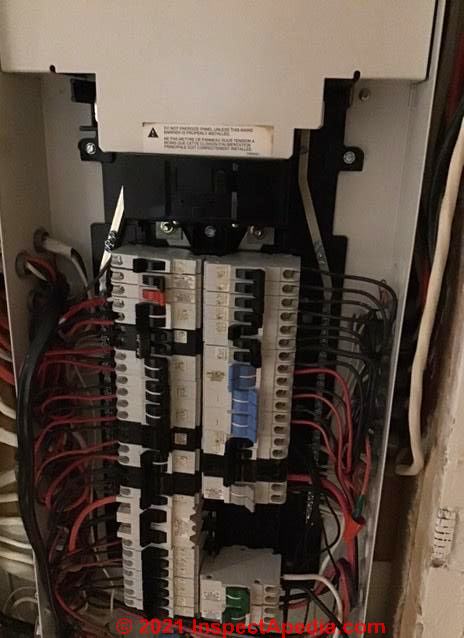
On 2020-05-23 - by (mod) - Can I assume that my 1988 FP Federal Pioneer electrical panel is OK?
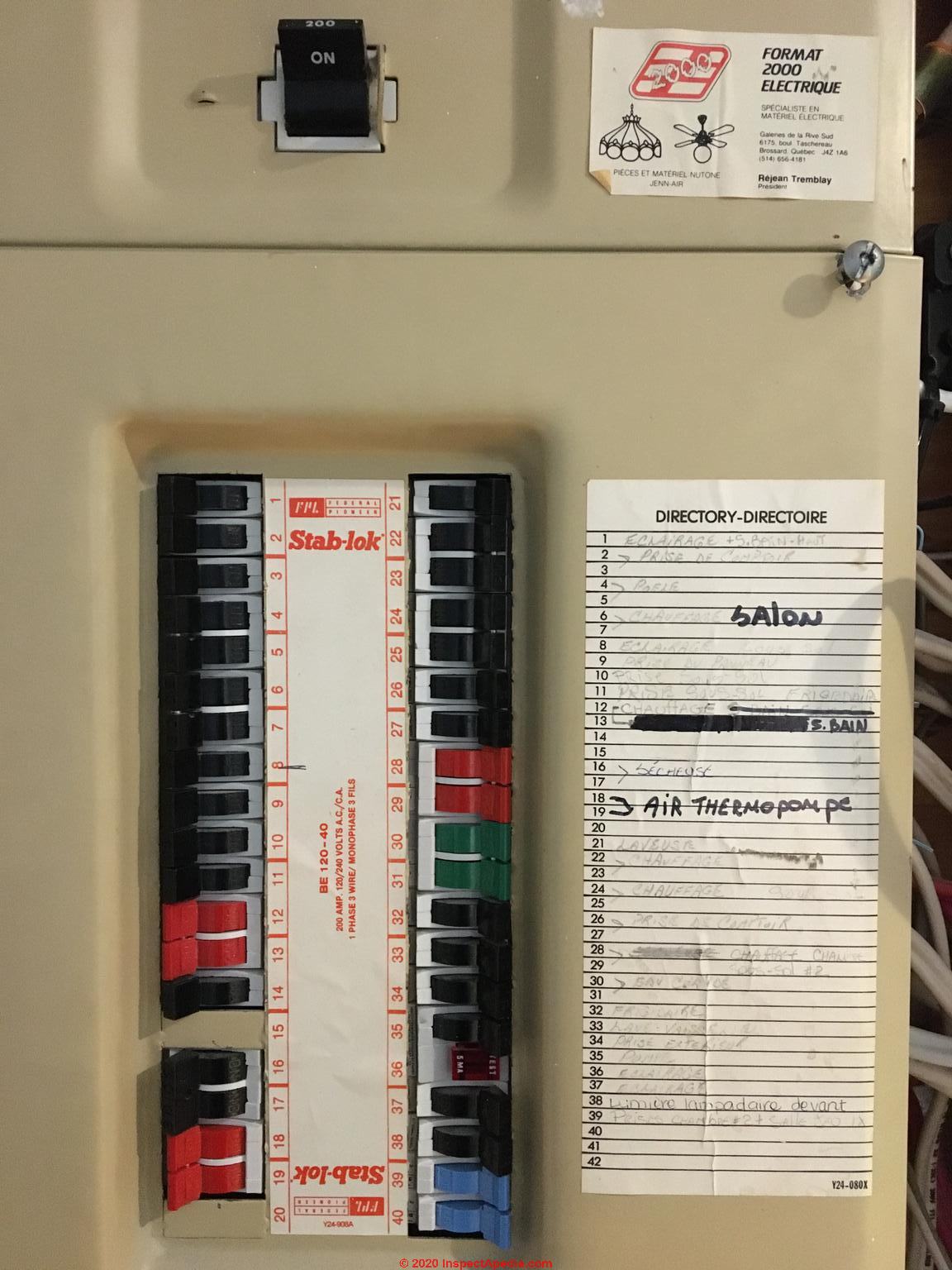 No Jean-Cristophe,
No Jean-Cristophe,
Do not assume that your 1988 Federal Pioneer panel is "OK".
In my experience and thus opinion, your panel is clearly a "stab-lok" design - that's the same design that went un-modified for decades and was problem and failure prone across all of its models.
On 2020-05-23 by Jean-Christophe Shaw
Hi, my electrical panel is a FPL Federal Pioneer (not FPE) installed in 1988 (see image) in Québec, Canada.
So, the test failure seem to be just for panel fabricated between 1992 and 2015. Should i conclude that my panel is ok because he is fabricated in 1988?
On 2018-11-21 - by (mod) - field report of 2000 Federal Pioneer Stab Lok panel breaker failure to trip
Rufus,
Thank you for an important field report. Your personal experience echoes Dr. Aronstein's independent test results that show convincingly that Canadian FP Stab-Lok breakers, both recent-models (2000) and even new stock purchased from suppliers have a worrying high rate of failure to trip.
In Canada where the government is the authority who approved that equipment in the first place, probably because of liability concerns, in my OPINION Ontario Hydro is never going to acknowledge that the equipment that they approved is now considered unsafe and should be replaced. Ditto for the manufacturer.
On 2018-11-21 by Rufus Simon - Ontario electrical inspector does not certify work connected to a Canadian FP electrical panel
I have a Federal Pioneer stab-lok panel which was installed in the new house in the year 2000.
I have twice experienced the circuit breakers failure to trip. In one case the lamp switch blew but the breaker failed.
I recently finished my basement and added the basement circuits to the additional breakers on the same panel.
The Ontario electric inspector made his second visit to certify the completed work.
Though satisfied he would not certify the work connected to the FP stab-lok panel.
I am supposed to add a sub panel and transfer the basement circuits to the new sub panel.
What is the Ontario Electrical Certification say about this.
Reader Question: Is this FP Panel one of the model that may be defective ? and that should be replaced ? - Boite Electrique Federal Pioneer en Canada?
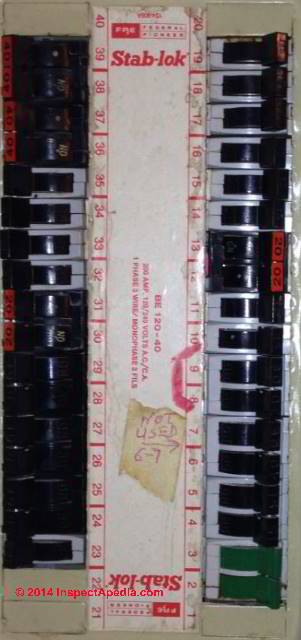 I have the following electrical panel from Federal Pioneer that is 30+ years old. Is this one of the model that may be defective ?
I have the following electrical panel from Federal Pioneer that is 30+ years old. Is this one of the model that may be defective ?
and that should be replaced ? Is there any recall ?
[Are there] funds available for replacement ?
Thank you in advance - Louis - 3/3/2014
Reply: history and limited field data indicate FP panels and fail at the same rate as US FPE equipment - these are hazardous but
we lack a larger body of independent research or updates from the manufacturer about Canadian Federal Pioneer breaker & panel design, design changes, performance
Louis:
The short answer is we have less actual data on which to base a conclusion but all of the history and the limited evidence we do have suggests that it'd be meaningfully safer to replace the panel.
In addition to seeing breakers held in place by adhesive tape in FP panels, a search to identify ANY design or manufacture change that would support a claim of greater safety than the US FPE mark led nowhere but to stonewalling.
You'd think if there was good news the manufacturer would share it.
But the facts are more complex. In my OPINION even if a manufacturer had improved the design of a product to make it more safe, they'd be reluctant to say so out of concern for admitting liability for prior versions of the product.
See FP FEDERAL PIONEER in CANADA.
Without more field data and independent testing one cannot not assume that the newer Canadian Federal Pioneer electrical panels and circuit breakers have been proven unacceptable or unsafe, but given the very bad performance of the original designs of the original FPE Stab-Lok® product which were widely sold over many years, one should not fail to look for (or wish for) more current test and engineering data on this product.
(The photo shows the data label in a Federal Pioneer electrical panel model NBLP32B-4NBCFB taken in 1997)
Comments & Questions for Schneider about FP Panels
If it were my home and my panel shown at the top of this page, I would call the Schneider Electric company and, in as respectful a manner as I could, I’d simply put these questions to them
- The older versions of the product clearly had problems in the U.S. and at least some failures in Canada, (there was a Canadian product alert notice). That FPE product design and even equipment were put into production for a Canadian version sold as FP or Federal Pioneer.
- Schneider Electric Co. has continued to produce and sell the Federal Pioneer brand electrical panel.
- Newer Federal Pioneer electrical panels and breakers, though they may still be a Stab-Lok® design, look a little different than the older ones by simple visual inspection of the electrical panel and circuit breaker colors and toggle switch handles.
We don't know if that difference is cosmetic (for example different plastic used to form molded circuit breaker cases) or more substantial. - Can or will Schneider Electric provide any test reports or technical data about any changes or improvements in the product since the era when Schneider picked it up? The company did not reply to a request for product design or manufacturing change, update, or history information.
The Federal Pioneer breaker box and Stab-lok issue - US vs Canadian product & data
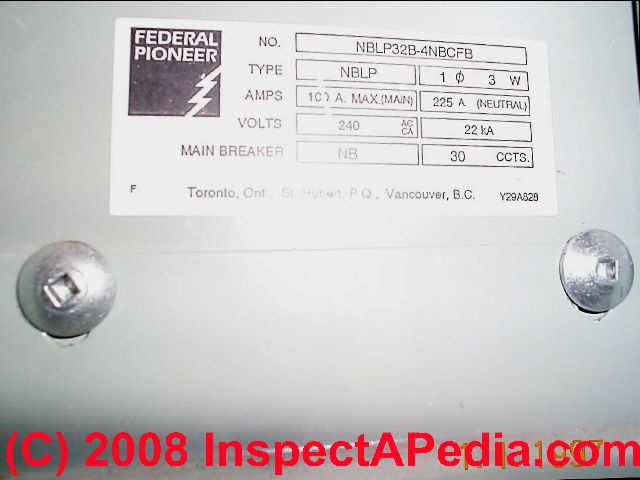 Reader Question:1992 FP panel stamped CSA is OK?
Reader Question:1992 FP panel stamped CSA is OK?
Thank you for the excellent website, which I’ve used to research many issues.
In the course of researching an unrelated issue I came across the pages related to Federal Pacific/Pioneer breaker boxes and Stab-lok breakers.
We have a 1992 installed Federal Pioneer panel in our house and I am trying to understand better the risks involved in its continued use. New CSA-stamped (but not UL-stamped) Stab-lok breakers are readily available here in Canada, and several of these have been installed by electricians during renovation projects over the last few years.
https://inspectapedia.com/electric/Used-Circuit-Breaker-No-Trip-Failures-2017-10-13-JA.jpg
The graphic above shows the failure rates of various brands of breakers. It was a bit difficult to count the small dots, so the numbers might not be exact, but by my count something like 15% of the FPE breakers failed to open by 135% of the current rating and about 3% failed to open at all.
That seems to be about “middle of the road” for the brands listed in that graphic. The graphic indicates that this represents the testing of 3000 used FPE breakers, which is a large enough sample to be statistically significant. Do you have data on the sample sizes for the other vendors for a comparison?
It would be nice to see every breaker open by the rated current level throughout its life, but making any mechanical device close to 100% failure proof becomes prohibitively expensive.
I would guess that 85% of breakers tripping by their target amperage and 97% tripping by 200% of the current rating (the FPE results) would be about what would be expected for used breakers of any brand. I’m struggling to understand why you recommend replacement of these boxes/breakers when the large sample test results seem reasonable. Could you expand on that, please?
I do understand that there is anecdotal reports of problems with the internals of the boxes and the fixation of the breakers and problems may not be related to the breakers themselves.
Regards, - Anonymous by private email 2017/11/18
[The writer is a professional engineer living in Canada - Ed. ]
Reply: OPINION: why we think that it would be prudent to replace a Canadian FP electrical panel
Thank you for the question and discussion, Chris. I very much welcome your opinions.
Preceding more comments by a bottom line OPINION as my current-best-answer to your question of why we think that it would be prudent to replace a Canadian FP electrical panel:
Having spent many years researching and asking for data on Federal Pioneer equipment and having not been able to obtain a single shred of information confirming any design improvement in those breakers from ones made in the U.S., I cannot safely assume that the Canadian product was amended in design or in manufacture to eliminate the known hazard of a risk of failure to trip.
FP breakers are virtually identical in internal design as FPE breakers. A good part of the FPE failure problem is traced to innate design limitations of the product.
A review of the product history suggests that the product's price point (at the low-end) precluded a costly redesign. In the U.S. product problems were also traced to the manufacturing process and equipment - there *might* be differences in the Canadian product manufacture, or possibly not: some of the very same equipment can be in continued use.
The few FP failures for which we have clear reports showed failures in exactly the same manner as the US products. To me that suggests that the products are essentially identical. "Essentially identical" is itself, however a tricky descriptor.
Part of the historic problem with FPE was that small changes were made continually over the manufacturing life of the product, without re-certification, and unfortunately, without any evidence that later-made products performed any better than earlier-made products.
I have previously asked Schneider to comment-on and offer information or updates about FP breakers sold in Canada.
The company's reluctance to provide any information whatsoever about their Canadian version of the product, its design, manufacture, testing in-house or by independent labs, or about product changes offers nothing to dispel the known hazards and failures we've documented.
The most-generous reading I can offer for that silence is that in a climate of litigious class-action-seeking lawyers, companies might be reluctant to say they've corrected an unsafe product because that amounts to admitting that they may have an installed base of tens of thousands of the older product remaining use.
That means that the company either has to go through a costly product recall or face elevated liability. In the most-responsible case a company executive board may make an informed guess at what's the proper cost/benefit analysis. That information is not public.
Searching via Google for "buy replacement Federal pioneer circuit breaker" will return results for a range of products from several sources including UBI.
"Replacement" FP and FPE breakers being sold by UBI UBI FPE CIRCUIT BREAKER TEST RESULTS https://inspectapedia.com/fpe/FPE-UBI-Replacement-Circuit-Breaker-Tests.php have an even worse performance rate. What protects consumers against installing those in a Canadian electrical panel?
Searching for "Canadian Electrical Panel Fires" will quickly turn up OPINONS expressed by electricians that appear to me to be pulled out of thin air, such as this claim
"Supposedly, the FPE breakers sold in Canada were a different design than the ones sold in the US. So you may be ok." - retrieved 2017/11/20 original source: https://vibrantvictoria.ca/forum/index.php?/topic/2551-any-electricians-or-building-inspectors-here/
followed on the same page by this comment that you should take as a warning given by another Canadian electrician:
"I'm hoping, but I have also read people pulling Canadian panel covers off to find US made breakers "
A fundamental error in the thinking of many if not most people, including electricians and one of the moderators who comments in the website above, is the claim that since an FP panel has been in a building for many years with out ever showing the slightest sign of trouble then that proves the product is perfectly safe.
What's mistaken in this view is that the speaker/writer doesn't realize that nothing will go wrong with a circuit breaker that won't trip when it should ... until something goes wrong. If a building's electrical use, wiring, or lack of damage has never caused a short or over-current, then sure, nothing has ever gone wrong, nothing has called on the breaker to trip, and it just keeps happily passing current along with no trouble.
Absence of evidence is never evidence of absence.
You're riding around in your 65 Mustang with seatbelts that have worn through, down by the floor where you never look, to a single thread. You buckle up and drive to Canadian Tire for some air filters. Nothing goes wrong, and your seat belt is working perfectly.
But during that trip, despite your assumption, you were not receiving the seat belt protection that you thought you could count upon.
Had you been in a crash, things may have ended less happily.
Other comments:
If you didn't find it, FEDERAL PIONEER PANEL SAFETY sums up what we know to date on those specific brand panels.
When I first spoke with a Schneider engineer about their currently-sold FP breakers some years ago, he was interested, helpful, and said he was not aware of the product failures and would talk to older engineers and get back to me. The company had no further comment.
I have seen first hand FP breakers falling out of Canadian panels - held in by Scotch tape. That is an innate product design issue found also in some U.S. FPE panels and it is separate from the circuit breaker no-trip problem.
Some of our field reports on failures are from FP, but the greater volume is from US readers as I explain and analyse below.
The smaller number of field reports on Canadian FP panels might be due to any of a plethora of unknowns such as
- Actual product differences and/or better field performance of the product (that would be great news but we lack data to support this claim nor to refute it - Ed.)
Field reports include just a dozen citations of Federal Pioneer panel failures.
One (from Toronto in 2009) at FPE FAILURE FIELD REPORTS include a reader's observation that the bus bars in some FP panels may be different than in some U.S. FPE panels.
However, while there are some bus-connection problems and burning, the principal failure mechanism in FPE (and probably FP) circuit breakers is not the bus connection but rather the internal parts of the circuit breaker - they jam.
The bus burning reported by some and also discussed at InspectApedia is more-likely an effect than a cause of FPE / FP failures. - Differences in electrical fire reporting:
see ELECTRICAL FIRE OCCURENCE & REPORTING CANADA VS. U.S. - Low inclination to report electrical product failures
Watch out: we estimate that many electrical panel failures are discovered and repaired before a fire occurs when a circuit is misbehaving or a building occupant notices other trouble signs. We also estimate that less than 1% of such failures are ever reported to any authority at all.
The electrician makes a repair or installs new equipment and the old failed equipment is thrown out. There are in fact negative incentives to report such failures in both the U.S. and Canada. As a result we consider field reports to be more important than their small number may suggest. - Demographic differences: percentage of people living in lower-quality, lower-cost, older housing stock and lack of fire data for Canada. See Fire Occurrence Data below.
- Ratio of Canadian to U.S. Populations & FPE-FP Readers of the information on FP/FPE to U.S. readers is roughly 10-12. In the twelve months ending 20 November 2017 InspectApedia.com had twelve-times as many U.S. readers as Canadian readers.
As recent population estimates put the Canadian population at 36.3 million and U.S. population at 323 million, you can see that the ratio of Canadian to U.S. readers of FPE data is likely to be similar to differences in the two total populations.
The number of reports of electrical fires and electrical panel failures would be expected to occur in a similar ratio. - Ratio of total number of Federal Pioneer Electrical panels in Canada to Federal Pacific Electrical Panels in the U.S. - it's likely that the total installed base in the U.S. is much larger.
- Better or just different electrical wiring practices / better construction, fewer overcurrents in Canadian homes (do Canadians plug in as much junk as do Yanks?)
- Fewer class action attorneys in Canada than in the U.S. and possibly, differences in consumer law between the countries. While we could not find exactly equivalent reporting on the number of class action lawsuits in Canada and the U.S. the data below gives a sense of the differences between the two countries. [The U.S. does not maintain a list of nonsecurities class action settlements].
Canada: The research of some commentators reveals at least 287 proposed class proceedings were filed in Ontario between 1993 and April 2001. (Bogart eta al 2007)
United States: 306 class action lawsuits were filed in a single U.S. county in 2001. - U.S. Senate Congressional Record 7 July 2004 pp. 14518-14519. IN 2001 just two companies, Microsoft and State Farm together faced over 250 class action lawsuits. - Aaron, Henry, James M. Lindsay, and Pietro S. Nivola, eds. Agenda for the Nation. Brookings Institution Press, 2003. p. 542
I do not agree with your premise that a 15% failure rate for older circuit breakers might be "pretty good", nor that it is to be expected uniformly across all breaker or panel brands.
Take a look at CIRCUIT BREAKER FAILURE RATES at https://inspectapedia.com/electric/Circuit_Breaker_Failures.php (click to enlarge tables or images) and you'll see that while FPE/FP are by no means the only problem brand, there are rather dramatic differences in failure rates among breaker / panel brands with not much in the "middle ground" between performing very well and performing badly. You will see that none of the good-performing brands fail at 15% rates.
Consider that a circuit breaker is protecting people from fire, shock, possibly fatality. A 15% chance of those outcomes would be unacceptable to most people, codes, authorities.
If Bryant or Square D (good performing brands) for example, were failing at a significant rate after the passage of time and if that were truly unavoidable, I think we'd have seen a move by the industry to recommend breaker replacement in all buildings in all cases after some number of years of service.
I think of these more like an automobile seatbelt. I drive an older car that came equipped with factory seatbelts. If I were told that after 15 years my seatbelts had a pretty good chance of failing in a crash I'd be rather troubled. It's a device that people use, count-on, and upon which they do not spend one minute of their day in worry.
A brief summary about InspectAPedia.com can be read at https://inspectapedia.com/About_Us.htm
Thanks again, I welcome your comments, experience, and any data you can find on Canadian electrical failures.
Daniel
cc: Jess Aronstein
InspectAPedia is an independent publisher of building, environmental, and forensic inspection, diagnosis, and repair information provided free to the public - we have no business nor financial connection with any manufacturer or service provider discussed at our website.
We are dedicated to making our information as accurate, complete, useful, and unbiased as possible: we very much welcome critique, questions, or content suggestions for our web articles. Working together and exchanging information makes us better informed than any individual can be working alone.
More information about this website is at ABOUT InspectApedia.com
...
Continue reading at FEDERAL PIONEER PANEL SAFETY - topic home, or select a topic from the closely-related articles below, or see the complete ARTICLE INDEX.
Or see these
Recommended Articles
- CHALLENGER ELECTRIC PANELS where an apparently-identical FPE Stab-Lok breaker is discussed.
- CIRCUIT BREAKER FAILURE RATES
- BACK-WIRED ELECTRICAL DEVICES
- BRYANT ELECTRICAL PANEL AGE & PROPERTIES
- Classified CIRCUIT BREAKER WARNING
- FEDERAL PACIFIC FPE HAZARDS - home
- MURRAY CIRCUIT BREAKER HAZARDS
- MURRAY SIEMENS Recall
- PUSHMATIC - BULLDOG PANELS
- SIEMENS MURRAY Recall
- SPLIT BUS ELECTRICAL PANEL HAZARDS
- SQUARE-D AFCI RECALL 2004
- SQUARE-D COUNTERFEIT BREAKER RECALL
- TEST MAIN BREAKERS & FUSES
- UBI FPE CIRCUIT BREAKER TEST RESULTS
- ZINSCO SYLVANIA ELECTRICAL PANELS
- COUNTERFEIT FPE CIRCUIT BREAKERS
- FEDERAL PACIFIC FPE HAZARDS - home
- FP FEDERAL PIONEER in CANADA
Suggested citation for this web page
FEDERAL PIONEER PANEL SAFETY FAQs at InspectApedia.com - online encyclopedia of building & environmental inspection, testing, diagnosis, repair, & problem prevention advice.
Or see this
INDEX to RELATED ARTICLES: ARTICLE INDEX to FPE STAB-LOK BREAKERS & PANELS
Or use the SEARCH BOX found below to Ask a Question or Search InspectApedia
Ask a Question or Search InspectApedia
Try the search box just below, or if you prefer, post a question or comment in the Comments box below and we will respond promptly.
Search the InspectApedia website
Note: appearance of your Comment below may be delayed: if your comment contains an image, photograph, web link, or text that looks to the software as if it might be a web link, your posting will appear after it has been approved by a moderator. Apologies for the delay.
Only one image can be added per comment but you can post as many comments, and therefore images, as you like.
You will not receive a notification when a response to your question has been posted.
Please bookmark this page to make it easy for you to check back for our response.
IF above you see "Comment Form is loading comments..." then COMMENT BOX - countable.ca / bawkbox.com IS NOT WORKING.
In any case you are welcome to send an email directly to us at InspectApedia.com at editor@inspectApedia.com
We'll reply to you directly. Please help us help you by noting, in your email, the URL of the InspectApedia page where you wanted to comment.
Citations & References
In addition to any citations in the article above, a full list is available on request.
- FPE Field Failure Reports Wanted: Contact the Author to report problems you have observed or experienced with this equipment, Federal Pacific Electric Stab-Lok® panels, circuit breakers, replacement circuit breakers of any brands and type used in FPE panels. Inspectors or consumers should also report failures and FPE issues by sending an Incident Report to the US CPSC - please email us with the same information.
- Note: as we didn't add this reviewers list until 2007, this list of technical reviewers is incomplete; we have received comments and suggestions regarding this topic, edits and remarks included, from engineers and management from the US CPSC, electricians (many listed at our page on field reports of FPE failures), home inspectors, licensed electricians, and electrical engineers, and even a few attorneys and real estate agents, since 1986. Technical review, critique, content suggestions, questions, or clarifications are invited and where a contributor wishes, credit and links will be provided to that source. Contact us to provide feedback.
- Dr. Jess Aronstein, electrical engineer, Poughkeepsie, NY, forensic engineering services, independent laboratory testing for various agencies protune@aol.com (independent electrical panel testing, including FPE Stab-Lok® panels, to April 2010)
- David Carrier, electrical engineer, 53 Henmond Blvd., Poughkeepsie, NY 12603 845-430-7527 davidwcarrier@earthlink.net (independent electrical panel testing, including FPE Stab-Lok® panels, beginning 2010)
- Alan Carson, Carson Dunlop Associates, Toronto, Ontario. Mr. Carson is a home inspection professional, educator, researcher, writer, and a principal of Carson Dunlop Associates, a Toronto home inspection and education firm. Mr. Carson is a past president of ASHI, the American Society of Home Inspectors
- Mark Cramer Inspection Services Mark Cramer, Tampa Florida, Mr. Cramer is a past president of ASHI, the American Society of Home Inspectors and is a Florida home inspector and home inspection educator.
- Carl Grasso, Esq., Herzfeld & Rubin, New York, NY. Mr. Grasso is an attorney who managed a plaintiff's class action litigation against Federal Pacific Electric in New Jersey.
- William King, US CPSC Director of Electrical Engineering (Ret).
- Our recommended books about building & mechanical systems design, inspection, problem diagnosis, and repair, and about indoor environment and IAQ testing, diagnosis, and cleanup are at the InspectAPedia Bookstore. Also see our Book Reviews - InspectAPedia.
- 2007 FPE Stab-Lok® TECHNICAL REPORT - an updated test report of independent testing (a large 1.2MB PDF file) using a larger pool of FPE Stab-Lok® circuit breakers than the older CPSC and Wright Malta tests found significantly higher failure rates of FPE Stab-Lok® circuit breakers, including a look at critical safety failures (breaker failed to trip at 200% of rated current or jammed) which found up to 80% failure rate for FPE Stab-Lok® GFCI circuit breakers (n=4), 12% failure rate for double pole FPE Stab-Lok® circuit breakers (n=120), and a 1% failure rate for FPE Stab-Lok® single pole circuit breakers (n=345).
- In addition to citations & references found in this article, see the research citations given at the end of the related articles found at our suggested
CONTINUE READING or RECOMMENDED ARTICLES.
- Carson, Dunlop & Associates Ltd., 120 Carlton Street Suite 407, Toronto ON M5A 4K2. Tel: (416) 964-9415 1-800-268-7070 Email: info@carsondunlop.com. Alan Carson is a past president of ASHI, the American Society of Home Inspectors.
Thanks to Alan Carson and Bob Dunlop, for permission for InspectAPedia to use text excerpts from The HOME REFERENCE BOOK - the Encyclopedia of Homes and to use illustrations from The ILLUSTRATED HOME .
Carson Dunlop Associates provides extensive home inspection education and report writing material. In gratitude we provide links to tsome Carson Dunlop Associates products and services.


